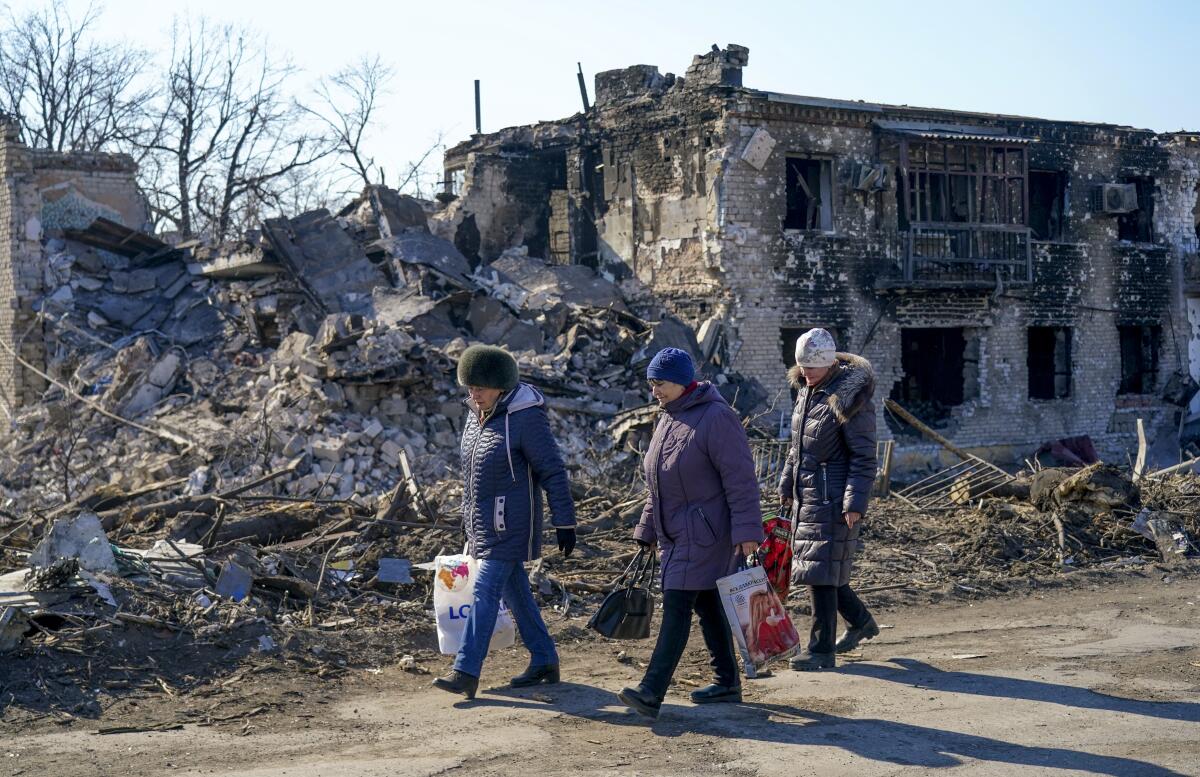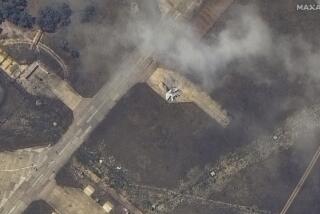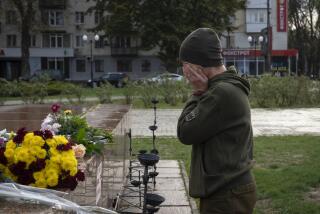Russia intensifies its assault with fresh strikes on eastern Ukraine

The decisive fight for Ukraine’s east began this week as Russia mounted attacks in the Donbas region.
- Share via
KRAMATORSK, Ukraine — Determined to seize control of Ukraine’s industrial heartland, Russia on Tuesday intensified its assaults across the country’s east while keeping up the bombardment of Ukrainian forces in the besieged southern port of Mariupol.
Russian Defense Ministry spokesman Igor Konashenkov said that in 24 hours, Russian forces had launched strikes against more than 1,200 Ukrainian military facilities and targeted more than 1,200 troop concentrations, details that could not be independently verified.
Ukraine says Russia has begun its long-expected all-out assault on the east — and Moscow’s top diplomat confirmed Tuesday that the struggle has entered its next stage. Western military officials and analysts warned that the current Russian attacks may be setting the battlefield for a larger and potentially far more brutal offensive planned by Moscow.
Ukraine war heroes: A student spiriting supplies to soldiers. A DJ answering calls about the missing
More than 4.6 million Ukrainians have fled since Russia invaded, but millions more have stayed to help defend their country. These are their stories.
“We think that these offensives are preludes to larger offensive operations that the Russians plan to conduct,” a Pentagon official said Tuesday. The official, who spoke on condition of anonymity, said Russia still has about 75% of the soldiers and weapons it assembled before the Ukraine invasion and is currently conducting “shaping operations” that will lay the groundwork for more significant strikes.
On a call with key allies Tuesday, President Biden discussed providing more ammunition and other security assistance to Ukraine and imposing new economic penalties against Russia, the White House said.
White House Press Secretary Jen Psaki said the U.S. is preparing another round of sanctions against Moscow that could be announced this week.
European Commission President Ursula von der Leyen confirmed for the first time that Europe is planning an embargo on Russian oil imports. “We are currently developing clever mechanisms so that oil can also be included in the next sanctions step,” she told Germany’s Bild am Sonntag newspaper in an interview over the weekend.
While the European Union has already banned the import of Russian coal, many of its member states have been wary of giving up hydrocarbons. EU countries rely on Russia for roughly a quarter of their oil and more than 40% of their natural gas and worry that an abrupt embargo could devastate their economies.
Ukrainian authorities, meanwhile, implored civilians to get out of the eastern battle zone by any means possible, but acknowledged that for a third straight day there had been no agreement reached with Russia to set up humanitarian corridors for those fleeing the fighting.
United Nations Secretary-General António Guterres called Tuesday for a four-day pause in fighting to allow civilians to escape.
Guterres proposed that the cease-fire span Thursday to Sunday, coinciding with the Easter Holy Week celebrated in the Eastern Orthodox Church.
“Save lives. Stop the bloodshed and destruction. Open a window for dialogue and peace,” he said in a public plea to Russian and Ukrainian officials.
Guterres said more than 12 million people in Ukraine were in need of humanitarian assistance, with one-third spread between the eastern cities of Donetsk and Luhansk and the southern cities of Kherson and Mariupol.
In Mariupol, which has been largely flattened by Russian bombs that officials say have claimed some 20,000 lives, several thousand Ukrainian soldiers and hundreds of civilians have been holed up in a network of tunnels in a sprawling steelworks plant.
Russia has repeatedly pushed the Ukrainian forces hunkered in the plant to surrender, promising that those who lay down their arms “are guaranteed to remain alive.” But as happened over the weekend, the latest surrender deadline came and went without any sign of Ukrainian compliance.

A Ukrainian commander says Russia has been using “bunker-buster” bombs to try to dislodge the defenders.
Mariupol’s capture would likely be hailed by Russia as a pivotal triumph in a war that has yielded few of those for Moscow. It would free up more brigades for the eastern fight, as well as enable the creation of a strategically important land corridor between Russian-controlled areas and the annexed Crimean peninsula.
Russian President Vladimir Putin’s most important goal at this point in the war is to capture Mariupol, to be able to portray it as a major victory in whose glow he can cast the war effort on May 9, the Victory Day marking the defeat of Nazi Germany in 1945, a senior European official said Tuesday.
The official said satellite imagery shows that 90% of Mariupol has been destroyed, and given the many civilians who were not able to escape, the death toll is likely to be high.
“We do expect the complete destruction of the city and many civilian casualties,” the official said.
“My fear is that it is going to be worse than Bucha,” he said, referring to the Kyiv suburb that has become the focal point of some of Russia’s most vicious alleged attacks on civilians.
The official, who briefed a group of reporters on condition of anonymity because of the sensitivity of the information, said Putin’s focus on the east is part of a strategy to build a land bridge from the Donbas region to the Crimean peninsula that he annexed eight years ago. The plan also includes controlling the Kherson area, where fighting raged Tuesday, to secure freshwater canals to Crimea. Then, he wants to seize additional territory to the west of the Donbas as a buffer zone.
Moscow was initially silent on Monday night when Ukrainian President Volodymyr Zelensky declared that the war for Ukraine’s industrial east, known as the Donbas, had begun. The area is made up of two large regions, Luhansk and Donetsk, parts of which are already controlled by Russia-backed separatists who have been battling Ukrainian forces for eight years.
“We will fight,” Zelensky vowed in a video address. “We will defend ourselves.”
Russia appeared to confirm the wider offensive’s start when Foreign Minister Sergei Lavrov said in an interview broadcast Tuesday that “another stage of this operation is beginning.”
“I am sure this will be a very important moment of this entire special operation,” Lavrov told Indian television. Russia refers to Europe’s biggest land war since World War II as a “special military operation.”
Ukraine’s military said Tuesday that Russia’s apparent aim was to seize full control of the Donbas. Its general staff said in a statement that overnight and early Tuesday, “the occupiers made an attempt to break through our defenses along nearly the entire front line,” a distance of more than 300 miles.
All along the battlefront, Russian forces were probing for “sensitive spots” in Ukraine’s defense, presidential advisor Oleksiy Arestovych said. But speaking on national television, he predicted the offensive would fail because the Russians “simply do not have enough strength.”
Even so, civilian casualties were mounting. Luhansk regional governor Serhiy Haidai said on Ukrainian television that the town of Kreminna came under heavy artillery fire overnight, setting residential buildings ablaze.
In the northeastern city of Kharkiv, hammered by near-constant bombardment, five people had been killed by shelling in the last 24 hours, the regional governor said Tuesday.
South of there, in the contested city of Kramatorsk, a massive blast Tuesday afternoon sent people and dogs scurrying from the streets. Rescue crews said the explosion was caused by a Russian X-58 missile hitting a cement factory in the center of the city.
The missile had slammed through the factory’s roof, covering manufacturing equipment and other detritus in a fine gray dust. Beside the building were the remains of a large truck and the body of a factory worker covered by a yellow tarp, a gash on his face and a pool of blood at his side.
For many in the battle zone, there’s no clear distinction between a much-heralded new phase of fighting and what has already occurred during the nearly two months since Russia invaded its smaller neighbor.
In Avdiivka, less than two miles from the separatist-controlled city of Donetsk, shelling had been a constant backdrop, with many forced to live their lives largely underground. In one school, some 200 people took shelter in the dank confines of a basement, sleeping on mattresses laid over desks. They shared one bathroom, on the ground level.
A month ago, an artillery round smashed the fourth-floor apartment of the head of Avdiivka’s utility company, who gave only his first name, Rostislav, for reasons of privacy.
His family — a wife and three children, the youngest seven months old — found safety in the Black Sea city of Odesa. But the shelling stole a home whose purchase had cost him all he had.
“I’m 37, and I have nothing,” he said.
Standing in front of the ruined apartment building, he pointed out where the shell had hit, debris now in an organized pile on the side of the street. Nearby were gouges and craters in the sidewalk where other artillery rounds had fallen.
Despite Avdiivka’s proximity to the front lines of the eight-year war between Russian-backed separatists and Ukrainian forces, Rostislav described a community that flourished before the Feb. 24 invasion.
“There was work, money and happiness,” he said. Now, like so many other cities across the Donbas, it was virtually empty.
Asked if he planned to leave, he sighed.
“Not today,” he said.
Bulos reported from Kramatorsk, King from Berlin and Linthicum from Mexico City. Times staff writer Tracy Wilkinson in Washington contributed to this report.
More to Read
Sign up for Essential California
The most important California stories and recommendations in your inbox every morning.
You may occasionally receive promotional content from the Los Angeles Times.
















